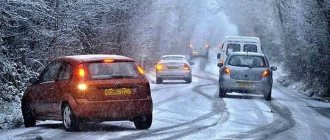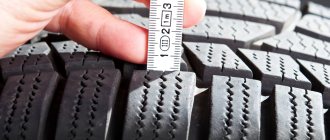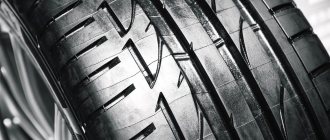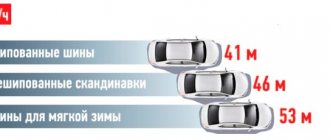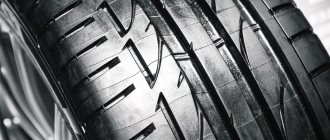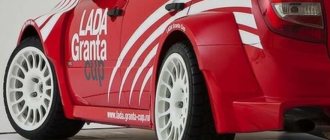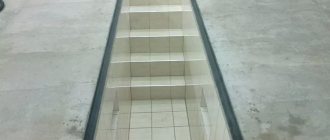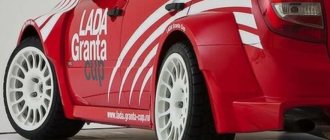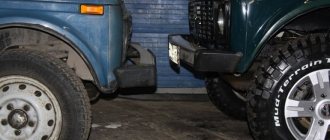The remaining tire tread depth is the height of the studs at which the tire can still be used. If the rubber is worn below the specified limit, further use of the product is not safe. Standards are determined for each category of car and type of tire individually according to traffic regulations. If the requirement is not met, it is considered a violation, punishable by a fine, and a traffic police officer, when checking wear and tear, issues a warning or a protocol for administrative punishment.
Tire tread depth 2022 traffic regulations residual pattern by category
5.1. The remaining tire tread depth (in the absence of wear indicators) is no more than:
for vehicles of categories L - 0.8 mm;
for vehicles of categories N2, N3, O3, O4 - 1 mm;
for vehicles of categories M1, N1, O1, O2 - 1.6 mm;
for vehicles of categories M2, M3 - 2 mm.
The remaining tread depth of winter tires intended for use on icy or snowy road surfaces, marked with a sign in the form of a mountain peak with three peaks and a snowflake inside it, as well as marked with the signs “M+S”, “M&S”, “MS” (if absence of wear indicators), during operation on the specified coating is no more than 4 mm.
(clause 5.1 as amended by Decree of the Government of the Russian Federation dated July 15, 2013 N 588)
Note. The designation of the vehicle category in this paragraph is established in accordance with Appendix No. 1 to the technical regulations of the Customs Union “On the safety of wheeled vehicles”, adopted by decision of the Customs Union Commission dated December 9, 2011 No. 877.
Constantly monitor the condition of studded tires
If the studs are still held in the tire, but at the same time swing from side to side, then the grip of the tire is significantly reduced.
If the studs are still held in the tire, but at the same time swing from side to side, then the grip of the tire is significantly reduced. A bendable spike will not cut into ice and has weak grip on slush and snow. Particularly dangerous are cases where a large number of studs have become loose and the number of studs in the tires varies.
According to the winter tire law, the maximum permissible variation in the number of studs between tires is 25%. This is useful for assessing the safety of your tires, but the results will always be a little inaccurate and unreliable, especially since drivers tend to overestimate the condition of their tires. That's why Nokian Tires has developed a tread wear indicator (DSI) for its new tyres, which accurately displays the remaining tread depth and the distance at which the tires will continue to provide adequate safety.
Tread depth of passenger car tires - how much is allowed and how it is measured
All car owners know that any tire gradually wears out. The more wear, the worse the car handles, and its cross-country ability decreases due to a decrease in the traction properties of the tire. This applies not only to winter but also to summer tires. In addition, the owner of a car with an erased pattern will face a fine for a critical reduction in tread depth.
Today we’ll figure out what the minimum permissible tread depth is allowed according to traffic regulations for different types of tires. How to measure it correctly using measuring instruments and improvised means.
Pattern height of new winter tires
Manufacturers do not indicate the tread depth of zero mileage tires. Perhaps the reason is the difference in this value for different standard sizes of products. Tread depth (mm) of new winter tires from some well-known brands, measured and published by customers:
| Name | Model | Tread height |
| Bridgestone, Blizzak range | VRX | 8,1 — 9,2 |
| Revo GZ | 9 | |
| Spike-01 | 10 | |
| DM-V2 | 10 | |
| DM-Z3 | 15 | |
| Bridgestone Ice Cruiser 5000 | Ice Cruiser 5000 | 10,1 |
| Nokian, Hakkapeliitta range | 8 SUV | 9,5 |
| K 2 SUV | 8,5 | |
| R2 | 8,4 — 8,5 | |
| 8 | 8,9 | |
| 5 | 9,3 | |
| R | 9 | |
| Michelin Latitude X-ice 2 | 8 | |
| Michelin X Ice range | 2Xi2 | 8,2 |
| 3 | 8,6 | |
| North 3, North | 9,4 | |
| Dunlop | Grandtrek At3 | 9 or more |
| Sp Winter Ice02 | 9,7 | |
| Sp Winter Ice02 | 8,8 — 9 | |
| Winter Maxx WM01 | 8,8 — 9 | |
| Yokohama | ice Guard IG30 | 8,4 |
| ice Guard Stud F700Z | 8,9 |
You can approximately determine the depth of the pattern with a coin. But it’s better if the driver always has his own meters at hand:
- tread depth (narrow ruler with movable stop);
- tire pressure - pressure gauge.
Traffic rules requirements
Let's take a look at the Rules of the Road to refresh our memory of the requirements for the minimum permissible tread depth of car tires. I would like to immediately note that these requirements are the same for Russia, Ukraine and the DPR.
Remaining tread depth values below which a fine is imposed:
- For cars and trucks up to 3.5 tons weighing – 1.6 mm;
- For trucks weighing more than 3.5 tons - 1 mm;
- Motorcycles – 0.8 mm;
- Buses with 8 or more passenger seats – 2 mm.
This applies to the operation of summer tires; winter tires have different requirements - the permissible minimum tread depth is at least 4 mm.
The difference between the requirements of traffic rules of the Russian Federation from Ukraine and the DPR
- The minimum tread value for winter tires is the same as for summer tires (Article 31.4.5). The Rules say that in winter, vehicles must be operated only with tires marked in the form of three peaks with a snowflake, the symbols “M+S”, “M&S”, “MS”, that is, on winter tires.
By the way, the traffic police inspector has every right to independently check the tread height using special measuring devices.
Functional differences between winter and summer tires
Tires can be summer, winter and all-season. The first ones are designed for driving on dry and wet asphalt, off-road in warm weather conditions, when the air temperature does not drop below +5 degrees. When it gets colder, the rubber on such tires hardens, which reduces road grip and creates the risk of an accident. Winter tires operate in more difficult conditions, and therefore the requirements for them are higher. These tires must provide traction on slippery roads (packed snow, ice), quickly remove mud from the mud, and also provide the vehicle with high cross-country ability. To achieve this, winter tires are equipped with the following elements:
- deep tread with large blocks;
- increased number of lamellas (side slits);
- drainage grooves;
- a special compound that maintains elasticity in the cold and follows the unevenness of the road.
Additionally, winter tires can be equipped with metal toe studs, which enhance the car’s grip on ice and compacted snow. Such tires are noisier in operation, increase the weight of the car wheel, but are necessary in regions with severe frosts and large amounts of precipitation. When moving around the city, there is no need for spikes, since the roads are regularly cleaned and treated with reagents.
All-season tires are an intermediate link between summer and winter tires. They are suitable for driving in cold and warm seasons, but cannot handle ice or wet asphalt as well as seasonal options.
How do you know if you have winter tires?
If an external inspection of the tread pattern of new winter tires does not allow you to clearly say whether the tires can cope with ice and compacted snow on the road, pay attention to the markings. Tires intended for the cold season have a pictogram with a snowflake against the backdrop of Trekhgorye, as well as the inscription “M&S” or “M+S”.
It is worth noting that according to the provisions of the technical regulations of the Customs Union TR CU 018/2011, winter tires with studs and appropriate markings can only be used from September to May, unless other restrictions are provided by the regional government. From June to August, cars must be equipped with rubber without any metal inserts.
How to measure the depth of a drawing yourself
Use special measuring instruments:
To measure, use a caliper with a depth gauge:
If you don’t have that either, you can use a coin. For residents of Russia you will need a coin with a face value of 2 rubles, for citizens of Ukraine - 10 kopecks:
Based on tire wear indicators
Car tire manufacturers have taken care of their customers. In order not to buy additional measuring instruments, you can monitor tread wear and its remaining depth using wear indicators. They are applied to the working surface of the tire contact with the road.
- Engraving on the tire in the form of numbers from 2 to 8. They indicate the tread depth and the height of the pattern. The wheel gradually wears out, erasing each number, the first to disappear is 8, then 7. If you see 2, it means there is 2 mm of depth left - it’s time to think about buying a new set.
- Wear indicators are hidden in the grooves - rubber partitions and protrusions. If the pattern has worn down to their level, then the tread height is 2 millimeters.
To make it easier to find the location of wear indicators on the tire, manufacturers put a “triangle” on the back side . It represents the arrow “Look here, they are here.” We look up at the working side of the wheel and find rubber protrusions in the grooves.
It is important that if winter tires have maximum wear, then repair studs cannot be installed on them. They won't hold onto it securely. There is a chance of damaging the cord during installation, this is more true for screw studs.
How to assess the degree of wear?
In addition to the visual test, there is a more accurate modern way to determine the level of wear.
Method No. 1.
For this, an electronic meter is used. There is one at the service station.
rice. Measuring device
It gives results accurate to a few microns, or calipers. If you don't have any of the above devices with you, you can use a coin or other object to measure.
Depth is measured along the main grooves.
Please note that the size of the geometry must be the same around the entire circumference. If the edge-to-center difference is significant, it may indicate improper air pressure, suspension failure, or an overly aggressive driving style.
Method No. 2.
It is quite intuitive and does not require special equipment. All he needs is an ordinary coin.
rice. Coin check.
It is enough to insert the coin vertically into the individual recesses. When the gold rim is completely hidden in them, the valid block value is preserved. It is advisable that inspection be carried out at several points, including both longitudinal and transverse grooves.
Thanks to this, it is checked whether the entire surface provides a safe value and whether the tire wears evenly during operation.
Method No. 3.
Measurement with miniature calipers. The principle of operation is simple. The measuring line is located at the bottom of the individual grooves.
rice. Measured using a caliper.
The top of the sensor is fixed to the top of the blocks. In this case, just like when measuring with a coin, you must remember to test in all grooves and at different points on the surface. Only then will the research be sufficiently reliable.
What affects the tread wear rate?
Finally, in order to adjust the scope of the article to its competitors, I will describe the factors affecting the durability of rubber.
Increased tire pressure. If you do not comply with the requirements of the car manufacturer and maintain excessive pressure in the ramp, then rapid wear of the central part occurs. It was she who had the most grip on the road, and quickly wore it out.
The wheel camber angle is incorrect. If there is increased wear on the outer parts of the tire, one or the other, this means that the wheel alignment needs to be adjusted.
If the tread wears off evenly but quickly , you have an aggressive driving style.
How to understand tire designations?
The tire size is the most important information printed on the tire. The size is indicated by numbers and letters, e.g. 195/65 R15 91H, where:
- 195 – tire width, mm
- 65 – tire height, % of width
- R15 – wheel arch diameter (landing diameter)
- 91 – load index
- H – speed index
- The speed index determines the maximum speed capabilities of the tire. The most important speed indices:
- Q – 160 km/h
- S – 180 km/h
- T – 190 km/h
- H – 210 km/h
- V – 240 km/h
- W – 270 km/h
All tires have markings that can be used to determine whether the tire meets EU, US, or both standards. The letter E, inscribed in a circle with two numbers, indicates that the tire has been tested in accordance with the safety requirements in force in the European Union. The American standard is designated DOT (Department of Transportation).
If tires are certified to both standards, they have both E4 and DOT designations. M+S: mud (Mud) + snow (Snow) – winter and all-purpose tires. AW (Any weather) are universal tires, as are AS (All Seasons). Some businesses use pictograms instead of letters: sun, rain, snowflake. An arrow on the side of the wheel indicates the direction of rotation of the tire.
The year of manufacture on the tire is indicated by four numbers: week and year of manufacture. For example, 1509: the first two digits are the fifteenth week (15), 09 is the year of manufacture (2009).
Conclusion
The remaining tire tread depth directly affects road safety. “Bald” tires will not only lead to loss of vehicle controllability and deterioration of the tire’s traction properties, but also to a fine. Traffic regulations are strict in this matter, and any traffic cop can only enjoy making money from a driver.
Be careful and control this parameter yourself. I also told you how to measure it yourself, you know what values are allowed. Now let's move on to fines: in Russia - 500 rubles or a warning (Article of the Administrative Code 12.5 part 1), in Ukraine - 340 hryvnia, in case of repeated violation - deprivation of rights.
In addition to penalties, there is a risk that the insurance company will refuse to pay in the event of an accident. If during the examination it was recorded that the car was driven on “bald” tires, then the chance of getting insurance is reduced to zero.
Add a comment Cancel reply
This site uses Akismet to reduce spam. Find out how your comment data is processed.
Source
What does a car owner risk when buying used tires?
- There is no warranty for tires purchased second hand;
- the seller can deceive - for example, offer tires from different manufacturers in one set. Some particularly enterprising sellers even cut tread into worn rubber, as if the tires were not yet worn out;
- you will have to spend a lot of time selecting tires from private sellers - much of what is put up for sale is only suitable for recycling;
- Products may have hidden or visible defects. Visible ones are punctures, tears, cuts. A tire with a lot of damage may collapse while driving. Hidden defects include damage to the cord, which most often occurs after punctures or a strong impact. A car with such a malfunction may sway on the road and be unstable;
- the product was stored in improper conditions, for example, in direct sunlight - this reduces the service life of the tires and they will become unusable faster, even if the remaining tread depth is ideal;
- It is not always possible to carry out tire fitting in the presence of the seller; you will have to check the kit yourself after payment.
Without a specialist, you risk buying tires that you won't be able to use. Don't skimp on safety. Purchasing a new set of tires will require a larger investment, but will pay off with a long period of trouble-free operation.
Updated requirements for tire tread patterns from January 1, 2015
Good afternoon, dear reader.
This article will discuss updating the requirements for the tread pattern of car tires .
The regulatory changes will not take effect until January 1, 2015, but I recommend studying them in advance.
So, today the following documents will be considered: “List of malfunctions and conditions under which the operation of vehicles is prohibited” (text of the document here) and “Technical regulations on the safety of wheeled vehicles” (text here).
The meaning of tire tread pattern
The tread pattern performs several very important tasks:
- Helps push water out of the contact space between the wheel and the coating;
- Protects the tire from various mechanical influences, which are caused by the presence of uneven surfaces on the roads, and also prevents puncture of the tire when hitting sharp elements.
Preference for a specific type of pattern is given depending on the conditions in which the car is supposed to be used.
Proper selection of tires will significantly improve the smoothness and controllability of the vehicle, increase efficiency during emergency braking and contribute to a quick response to the steering wheel. Failure to match the selected tread to the operating conditions will significantly reduce the performance characteristics of the vehicle.
Changes to the list of faults
Let's start with the changes made to the list of faults for which the operation of vehicles is prohibited:
5.1. Passenger car tires have a residual tread depth of less than 1.6 mm, truck tires - 1 mm, buses - 2 mm, motorcycles and mopeds - 0.8 mm.
Note. For trailers, standards for the residual height of the tire tread pattern are established, similar to the standards for tires of vehicles - tractors.
5.1. The remaining tire tread depth (in the absence of wear indicators) is no more than:
for vehicles of categories L - 0.8 mm; for vehicles of categories N2, N3, O3, O4 - 1 mm; for vehicles of categories M1, N1, O1, O2 - 1.6 mm; for vehicles of categories M2, M3 - 2 mm.
Residual tread depth of winter tires intended for use on icy or snowy road surfaces, marked with a sign in the form of a mountain peak with three peaks and a snowflake inside it, as well as marked with the signs “M+S”, “M&S”, “M S” ( in the absence of wear indicators), during operation on the specified coating is no more than 4 mm.
Note. The designation of the vehicle category in this paragraph is established in accordance with Appendix No. 1 to the technical regulations of the Customs Union “On the safety of wheeled vehicles”, adopted by decision of the Customs Union Commission dated December 9, 2011 No. 877.
First of all, the categories of vehicles from the technical regulations that were not previously mentioned in the traffic rules are striking.
Let's compare the remaining tread depth before and after January 1, 2015:
| Remaining tread depth | Until January 1, 2015 | After January 1, 2015 |
| 0.8 mm | motorcycles and mopeds | L - mopeds, motorcycles, quadricycles, etc. |
| 1 mm | trucks | N2, N3, O3, O4 - trucks with a permissible maximum weight of more than 3.5 tons and trailers with a permissible maximum weight of more than 3.5 tons |
| 1.6 mm | cars | M1, N1, O1, O2 - cars, trucks with a permissible maximum weight of up to 3.5 tons, trailers with a permissible maximum weight of up to 3.5 tons |
| 2 mm | buses | M2, M3 - buses |
The changes affected trucks with a permissible maximum weight of up to 3.5 tons, i.e. trucks of category B. Previously, on such vehicles, rubber could be used until 1 mm of tread remained. From January 1, 2015, the requirements will be slightly more stringent - 1.6 mm. For example, these requirements will affect small trucks (Gazelle, Mitsubishi L200, Volkswagen Amarok, etc.).
In addition, additional requirements are being introduced for winter tires marked “M+S”, “M&S”, “M S”. Such tires must have a residual tread depth of at least 4 mm. Moreover, this value does not depend on what category of vehicle the tires are installed on.
Other restrictions
Tire expiration date
According to domestic standards, the service life of tires is 5 years from the date of their manufacture; these standards are regulated by GOST 4754–97 and 5513–97. Most car enthusiasts know how old their tires are. The first ones came with the car, and then they usually don’t forget about the replacement - the purchase is quite serious.
The tire usually has a manufacturing date on it. It is labeled differently by different manufacturers. How this or that ]marks a tire[/anchor] can be found on the manufacturer’s website.
In Russia, there is no liability for the use of old tires, but if, during the investigation of the circumstances of the accident, it becomes clear that the tire’s “old age” was to blame for the destruction of the tire, then the decision may not be made in favor of the owner of the car with such tires. And it doesn’t matter whether you are driving or the car is mostly stationary and only occasionally leaves. The fact is that tires are exposed to oxygen and sunlight, which gradually destroy the rubber and tire frame. Of course, you shouldn’t take old, but very little worn tires to the scrap yard. Just remember that neither summer nor winter age tires will have the same performance as before.
Tire defects
Of course, few people will replace a tire after a regular puncture with a nail, but if the damage is more serious, then the tire has only one path - scrap. Tire replacement is usually caused by significant damage to the sidewall, large holes in the tread, bending of the tire carcass, or damage to the integrity of the bead rings. Uneven tread wear with individual bald spots and the inability to balance the tire on a working rim will also force you to replace it.
Some drivers mistakenly mistake the colored stripes on top of the tire tread for wear indicators. It's actually a kind of barcode, an internal designation that shows the warehouse worker what size or model the tire is. In warehouses, tires are stored in a vertical position, so the sidewalls are not visible to employees. And the stripes uniquely identify the tire, which makes the job easier.
Some drivers mistakenly mistake the colored stripes on top of the tire tread for wear indicators. It's actually a kind of barcode, an internal designation that shows the warehouse worker what size or model the tire is. In warehouses, tires are stored in a vertical position, so the sidewalls are not visible to employees. And the stripes uniquely identify the tire, which makes the job easier.
Minimum permissible depth indicators
It is worth finding out what the permissible minimum tread depth is for winter tires. According to the indicators and tests performed, the minimum height indicators should be above the 4 mm mark. For safety reasons, tire manufacturers recommend replacing winter tires before reaching the minimum depth.
Also, the depth largely depends on the wheel size. You can look at the example of several Nokian tires:
- 175/70 R13. Here the height ranges from 9-11 mm.
- 185/70 R14. Indicators in this size are up to 12 mm.
- 195-205 R14/15. Here the indicators will be around 11-15 mm.
On some tires, the service life can be extended by cutting the tread, but this can only be done on rubber that is intended for this purpose, and comes with the following markings indicated on the tire:
These marks indicate that the manufacturer provides for cutting. The main benefits that a person will receive from this operation are the following: saving money and extending service life, reducing fuel consumption. It is also worth noting that you should constantly monitor the condition of the tire in order to avoid emergency situations on the road.
Wear indicators
High abrasion rates on the tread of a pneumatic tire may indicate a deterioration in the technical condition of the vehicle. Tire runout is caused by wheel imbalance, wear of the suspension ball joints, as well as a rough, careless driving style. (Turning with squealing tires, beating curbs, holes, and rails shortens the life of the tires).
Is one side of the tread more worn? The wheels are probably not balanced. Are the dual tires worn differently, do their outer diameters differ by 5mm? The car is considered faulty.
Regular wheel balancing allows you to avoid active tire wear. The driven wheels of most cars are installed perpendicular to the plane of the road, while the drive wheels are installed at an angle. If the angle is incorrect, the tire will wear prematurely and unevenly.
To help drivers and inspectors - wear indicators:
- protrusions at the bottom of the grooves (in the central zone of the treadmill), the height of each of which is equal to the minimum permitted tread depth;
- a protruding element, the fate of which is to wear out as it wears out and eventually disappear, located at the level to which the rubber can be worn;
- numbers cut out in different layers of the tread corresponding to its current depth (one number is erased and the next one appears).
